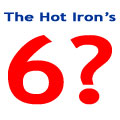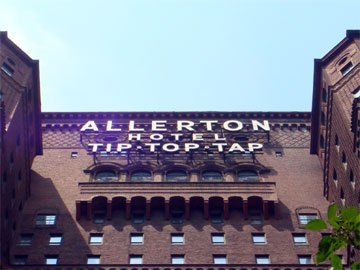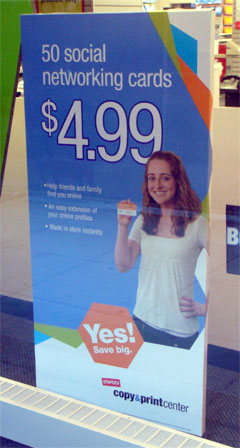Know Who Your Competitors Are
It helps to know who your competitors are. Why? Here are a couple of first-hand examples.
A few years back I was talking with a prospective client. Shortly into the conversation I realized they were looking for more services than I had capacity for, and more than I was in a position to handle. In short, they were looking for a larger firm. At the conclusion of the conversation, I told them this. The prospect then asked me if there was anyone else I could refer them to, and I gave them a name. Shortly after, they signed on with the firm I recommended, and I got a nice steak dinner out of it.
After I moved to Chicago from Boston, I continued receiving the monthly newsletters for Marty’s Liquors, a great food, spirits and cigar store in Newton and Allston, MA. I emailed them and told them I had moved and they could take me off their mailing list. The response I got from them was not what I suspected. They told me they were going to keep me on their newsletter mailing list, and if I wanted to buy anything in it, to go to Sam’s in Chicago and buy it there.
Both of these are examples of selfless, customer-focused networking. Recently I got a call from the firm in the first example, so I guess what goes around sure does come around.
Did you enjoy reading this? You are welcome to subscribe to The Hot Iron by RSS feed or by email.
A Domain Name Registration I Wish I Couldn’t Have Made
Yesterday I acquired the registration of a domain name I wish I wasn’t able to have made – bostonjaycees.org. Allow me to explain.
Back in 1997 I originally registered this domain name for the Boston Jaycees, an international, not-for-profit community service organization for young people between the ages of 21 and 40. I had recently joined and offered to build its first Web site. Over the years the Web site served as the main communication link for the chapter, especially when we decided to suspend printing a paper-based newsletter, and grew our email list to well over 600 people. I ran the Web site myself for a number of years, handing it off to our more than capable Administrative Vice President.
The Boston Jaycees, and Jaycees in general, have been a big part of my life for many years. I gained a tremendous amount of experience leading the organization, both as Administrative Vice President and eventually President. As an organization whose selling point is “leadership development thru community service” I benefited from the experiences of meeting people and leaders within the community. From the programs we put on to being Santa Claus to inner-city kids for many years, I feel I gained much more than I put into it. The pinnacle of this was when we did an exchange program with the Belfast, Northern Ireland Jaycees, and I had the opportunity to speak before a packed audience at Belfast City Hall, including many political leaders. Oh, and I met my wife through the Jaycees too!
I don’t know what specifically led to the domain name not being renewed, as I haven’t been involved in the Boston chapter for many years, especially now that I am in Chicago. As part of the domain name services offered by my Internet consulting firm Dunkirk Systems, LLC, I monitor domain names to ensure they are properly renewed. I had this domain name in my monitoring system… not sure why, probably more for nostalgia. Or perhaps because I have “rescued” many domain names for similar organizations? When I saw it was not renewed, I attempted – and succeeded – in acquiring the domain name using SnapNames, a premium service specifically for this purpose.
Why did I acquire the domain name? It is my hope that the domain name will be used once again for a Boston Jaycees chapter. I offer to manage this domain name at no cost to the chapter, just as I do for the Chicago Jaycees today, to ensure it is used for its intended purpose. I made an attempt to contact someone at the organization but never got a reply. I hope to be contacted soon, and can be done so through the contact form on the Dunkirk Systems, LLC Web site.
Did you enjoy reading this? You are welcome to subscribe to The Hot Iron by RSS feed or by email.
6 Questions with Justin Chen
 1 - Who are you, and what are you doing here?
1 - Who are you, and what are you doing here?
My name is Justin Chen and I'm an entrepreneur and co-founder of Menuism and The Wedding Lens. I got my computer science degree at UC Berkeley and then did the big company thing at HP for a few years before deciding that it was time to forge my own path and co-founded Two-Bit Operation LLC back in Feb 2006. Menuism was our first project and since we've been able to build that into a profitable business, we decided to add to our portfolio with The Wedding Lens. Menuism is the place to go for dish reviews of restaurants and all the restaurant menus (we aggregate menu links from AllMenus, MenuPages, GrubHub and the restaurant's own website). The Wedding Lens helps couples get all the full resolution digital photos from their wedding guests in a single album so they can download them from one place. Our goal is to solve simple problems while running a business that affords us the lifestyle flexibility that we've come to enjoy with self-funded entrepreneurship. I recently moved to Los Angeles, but my life as an entrepreneur started in Chicago, where I met a lot of great people and got help from the close-knit startup community there.
 2 - You talk about a balance between work and life; do you find other entrepreneurs who share that goal, or focus more on their ventures?
2 - You talk about a balance between work and life; do you find other entrepreneurs who share that goal, or focus more on their ventures?
Yeah, there are plenty of them, you just don't read about them as much in the press. The publicity usually goes to those that aim really big and make a lot of noise. Books like the "4-hour work week" have taught us all how to be more productive with our time and how to enjoy life as we work. I've done the shoot big 80-hour startup thing in the past and all I got out of it was burn-out, some worthless options and few t-shirts. I'm enjoying this route much more. Maybe I'm just getting old :)
3 - We're all getting old, but I digress. Can you describe how you interact and work with your team?
Now that there's 3 of us in 3 different cities (Chicago, Los Angeles, Seattle) we do most of our interaction over Skype, unlimited mobile-to-mobile minutes, and IM. We use Google docs & spreadsheets for all of our project planning, coordination and tracking and Assembla for our bug tracking.
The week starts with a team phone meeting where we discuss the status of our projects, any issues that may have arisen, and the plans going forward. From that point on, everyone works on their assigned areas and we do daily morning SCRUM emails to stay in sync with each other. Of course there's occasional IM chats and phone calls throughout the day for real-time updates or to bounce ideas of each other. Any contract workers or interns that we have also work virtually and are typically managed by a weekly call with one of us (just depends on who owns the area they're working on). It's very much a divide & conquer approach to moving things forward, but we'll still try to get together in the same place when we know that we're going to be doing heavy planning or development to make things more efficient (usually every couple months).
4 - Though you are in regular communication, you are still working alone. How do you stay motivated?
Day-to-day motivation and productivity definitely becomes difficult with isolation. We try to combat it by breaking all our initiatives down into bite-size tasks that we can individually tackle relatively quickly. When you have smaller tasks it feels like you're making progress by continually checking things off the to-do list. The daily scrum reports and weekly meetings provide the primary framework for accountability, but the burden still falls on the individual to stay productive and also keep the others on task as well (this is where nagging IMs and emails come in handy). We keep the team humming to the same tune through frequent re-centering meetings and a project dashboard (in google docs) that keeps our eyes on the goals and statuses of all our current efforts.
5 - Despite this, you have created some great sites, such as The Wedding Lens. Can you describe the creative effort that led to it?
So far, our projects have come out of quickly building solutions for our own needs and then rapidly evolving them, with Menuism solving our desire to know the best dishes to order at a restaurant. In the case of The Wedding Lens, the need stemmed from my wedding last July when we tried to find a way to consolidate all the high resolution photos in one place for everyone to download. Since we didn't want to be bombarded with tons of links to Picasa and Snapfish to view disparate albums, my business partner John whipped up a prototype the day after the wedding and asked our friends to upload their photos to it. Great feedback from our friends spurred us to give some serious thought about the business opportunity. We did some market research, identified our niche, solidified the product vision and within the next month we had version 1 ready for other couples to try out. After a few months of pilot testing by friends of friends and a redesign, we have TheWeddingLens.com as it stands today. We're pretty happy with the response from our customers and we're seeing an average of 600 photos per album, with some albums receiving over 1000 photos from their wedding guests.
6 - What is one question I did not ask, and what is its answer?
What advice would you give an entrepreneur that's just getting started?
1) Get out and talk to people: There are plenty of ways (local meet-ups, networking events, friends of friends, emailing bloggers, etc.) to meet people around you for coffee or drinks and you never know who you'll end up meeting. You'll also be surprised how receptive most people are to meeting with you if you just reach out to them and tell your story. When you're small, the free advice and potential partnerships you garner through these relationship building efforts are invaluable. Plus, once you've told everyone what you're planning to do, you have some public accountability to keep yourself on track.
2) Target a niche that you feel you can own: Not every company has to try to take over the world or even their industry. Scale your ambitions to your capabilities and how big you want to grow your business. By aiming to solve a particular need in an industry, you'll set yourself up nicely to partner with other players in the space.
3) Be efficient with your marketing dollars: Focus on efforts you can measure so you can improve your conversion rates, whether it's page views, signups, or sales. If it's a web venture, definitely spend some time learning about search engine optimization and social media marketing. The key is to find ways for your venture to keep marketing itself without continued direct effort from yourself.
Did you enjoy reading this? You are welcome to subscribe to The Hot Iron by RSS feed or by email.
There Is No Tip Top Tap
 High atop the Allerton Hotel on Chicago’s famed Magnificent Mile, Michigan Avenue, is the sign shown in the accompanying picture. It features the name of the hotel, as well as the name, “Tip Top Tap.” Where one would think there is actually a bar or lounge called Tip Top Tap inside the hotel, there is not. There once was, and for historical reasons the sign cannot change on the building. This article in the Chicago Tribune on the recent renovation of the hotel tells more of its story.
High atop the Allerton Hotel on Chicago’s famed Magnificent Mile, Michigan Avenue, is the sign shown in the accompanying picture. It features the name of the hotel, as well as the name, “Tip Top Tap.” Where one would think there is actually a bar or lounge called Tip Top Tap inside the hotel, there is not. There once was, and for historical reasons the sign cannot change on the building. This article in the Chicago Tribune on the recent renovation of the hotel tells more of its story.
Granted, the name Tip Top Tap does not sound contemporary by any modern standard. However, when there is a sign on both sides of your building, visible to millions each year, would you want to leverage this or simply ignore it? When the hotel was renovated, the space where the bar used to be was made into meeting space, and now there is a contemporary lounge on the second floor which, according to the hotel’s Web site, does not have a formal name.
This is not the only example of old names on buildings in Chicago. The former Marshall Field’s State Street store still carries its large name plaques even though it has been Macy’s for the past few years. Many banks dot the streets of the city with the names of their predecessor banks etched in stone and a plastic illuminated sign shows the current name. Though in today’s business mergerpalooza environment, there is probably little confusion as to what bank is what, and Macy’s still receives so much negative press in the Windy City that people know what really is on State Street.
I wonder how many people go into the Allerton Hotel looking for the Tip Top Tap? Count me as one, as my wife and I went in as she recalled her uncle’s stories of having cocktails at the bar many years back. Maybe if enough people go there asking for it management may consider returning the name? There is no shortage of brand and advertising people within a few blocks of the hotel to make it happen either.
Did you enjoy reading this? You are welcome to subscribe to The Hot Iron by RSS feed or by email.
Staples Cashes In On Social Networking
 Just in time for Colonel Tribune’s tweetup this evening in Chicago, an offer to help you when you meet people – social networking cards.
Just in time for Colonel Tribune’s tweetup this evening in Chicago, an offer to help you when you meet people – social networking cards.
So what is a social networking card? In reality is nothing more than a rebranding of the tried and true, standard business card. However since you may not be in business or want to represent yourself as an employee when at a social networking event, Staples had the foresight to take something they already sell – in-store made business cards – and offer them to a new market with a new name.
In my humble opinion there has not been a true replacement developed for the business card. Sure, you can beam contact information from one Palm device to another, send a text message to retrieve contact information or simply tell someone your social networking site or link. The business card works on a lot of levels. It is small, provides visual cues along with the information on the card and allows you to write on it, providing you did not get a gloss coating on it. And they work best in a crowded room, where it’s loud and busy, and you are trying to balance a drink in one hand and the last thing you want to do is tap on a portable device.
Will the business card be replaced? Maybe. But in the meantime, you should have your own, and they work best when you carry them on you.
Did you enjoy reading this? You are welcome to subscribe to The Hot Iron by RSS feed or by email.
Page 145 of 217 pages ‹ First < 143 144 145 146 147 > Last ›

